|
|
 |
|
Calanoida ( Order ) |
|
|
|
Clausocalanoidea ( Superfamily ) |
|
|
|
Scolecitrichidae ( Family ) |
|
|
|
Scaphocalanus ( Genus ) |
|
|
| |
Scaphocalanus curtus (Farran, 1926) (F,M) | |
| | | | | | | Syn.: | Scolecithrix curta Farran, 1926 (p.259, Descr.F, figs.F);
Scaphocalanus temporalis (M) Tanaka, 1953 (p.132);
? Scaphocalanus longifurca (M) : Tanaka, 1961 a (p.178);
Scaphocalanus similis Hure & Scotto di Carlo, 1968 a (p.157, figs.F); Hure & al., 1980 (p.298); Park, 1982 (p.122, figs.F,M); Kovalev & Shmeleva, 1982 (p.84); Scotto di Carlo & al., 1984 (1042); Scotto di Carlo & al., 1991 (p.271); Pancucci-Papadopoulou & al., 1992 (p.374); Vukanic, 2003 (139, tab.1); Vives & Shmeleva, 2007 (p.790, figs.F, Rem.); Mazzocchi & Di Capua, 2010 (p.427); Mazzocchi & al., 2011 (p.1163, fig.6, long-term time-series 1984-2006); Mazzocchi & al., 2012 (p.135, annual abundance 1984-2006); Belmonte, 2018 (p.273, Table I: Italian zones); Hirai & al., 2020 (p.1, Fig. 5: cluster analysis (OTU), spatial distribution).
? Scaphocalanus subcurtus Park, 1970 (p.476, 499, figs.F); Björnberg, 1963 (p.41, fig.F); Jeronimo Corral & Alvarez-Ossorio, 1978 (p.138); Kovalev & Shmeleva, 1982 (p.84); Vyshkvartzeva, 1993 (p.26, figs.F, Rem; Medellin-Mora & Navas S., 2010 (p.265, Tab. 2); Belmonte, 2018 (p.273, Table I: Italian zones)
Scaphocalanus glacialis Tanaka, 1953 (p.132 : nom. nud.); Park, 1982 (p.77) | | | | Ref.: | | | Farran, 1929 (p.209, 250); Rose, 1933 a (p.149, figs.F); Tanaka, 1961 a (p.183, figs.F, M); Vervoort, 1965 (p.64, Rem.); Hure & Scotto di Carlo, 1968 a (p.153, figs.F); Park, 1970 (p.497, figs.F,M, Rem.: p: 499) Bradford, 1973 (p.143); Björnberg & al., 1981 (p.637, fig.F); Park, 1982 (p.76); Bradford & al., 1983 (p.96, Rem.F, figs.F); Vyshkvartzeva, 1993 (p.13, figs.F,M, Rem); Campaner, 1984 a (p.167, figs.F, Rem.F); Roe, 1984 (p.357); Mazzocchi & al., 1995 (p.192, figs.F, Rem.); Bradford-Grieve & al., 1999 (p.881, 932, figs.F,M); Vives & Shmeleva, 2007 (p.758, figs.F,M, Rem.) | 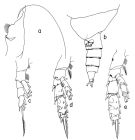 issued from : T. Park in Biology of the Antarctic Seas XI, Antarct. Res. Ser, 1982, 34. [p.123, Fig.29]. As Scaphocalanus similis. Female: a, forehead (lateral); b, last thoracic segment and urosome (lateral left side); c, P1 (anterior); d, P2 (posterior); e, P3 (posterior). Nota: The only difference shown by the present specimens from S. similis is the form of the last metasomal segment, which in lateral view is widely rounded instead of being narrowly rounded as illustrated by Hure & Scotto di Carlo (1968).
|
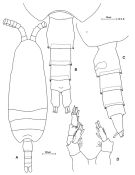 Issued from: M.G. Mazzocchi, G. Zagami, A. Ianora, L. Guglielmo & J. Hure in Atlas of Marine Zooplankton Straits of Magellan. Copepods. L. Guglielmo & A. Ianora (Eds.), 1995. [p.193, Fig.3.34.1]. Female: A, habitus (dorsal); B, urosome (dorsal); C, idem (lateral left side); D, P1. Nota: Head and 1st thoracic segment fused, 4th and 5th incompletely separated. Proportional lengths of urosomites and furca 34:18:18:10:20 = 100.
|
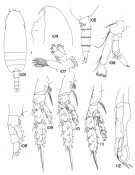 Issued from : T. S. Park in Bull. Mar. Sc., 1970, 20 (2). [p.498, Figs.103-112]. Identified as Scaphocalanus curtus Farran (1926). Female: 103, habitus (dorsal); 104, forehead (lateral); 105, posterior part of metasome and urosome (lateral left side); 106, A2; 107, Mx1; 108, P1 (anterior); 109, P2 (posterior); 110, P3 (posterior); 111, P4 (posterior). Nota: Mx1 with 10, 2, and 3 setae on 1st, 2nd and 3rd inner lobes, respectively; 5 setae on basis; 3+5 on endopod; 6 setae on exopod; and 9 setae on outer lobe. P5 lacking. Male: 112, P5 (endopod of right leg broken off), posterior.
;
|
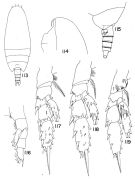 Issued from : T. S. Park in Bull. Mar. Sc., 1970, 20 (2). [p.500, Figs.113-119]. As Scaphocalanus subcurtus. With doubt. Female: 113, habitus (dorsal); 114, forehead (lateral); 115, posterior part of metasome and urosome (lateralleft side); 116, P1 (anterior); 117, P2 (posterior); 118, P3 (posterior); 119, P4 (posterior. Nota: Mouthparts as in Scaphocalanus curtus (Farran). Endopod of P1 with 4 setae (against 5 in curtus). P5 lacking.
|
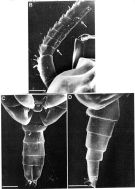 Issued from: M.G. Mazzocchi, G. Zagami, A. Ianora, L. Guglielmo & J. Hure in Atlas of Marine Zooplankton Straits of Magellan. Copepods. L. Guglielmo & A. Ianora (Eds.), 1995. [p.194, Fig.3.34.2]. Female (SEM preparation): B, A1 with transparent strip (arrows); C, urosome (ventral); D, idem (lateral left side).
|
 issued from : A.F. Campaner in Bolm. Zool., Univ. S. Paulo, 1984, 6 . [p.168, Fig.2a-d]. Female (off Rio de Janeiro): a, P1 (anterior); a1, spine (lessouter terminal basipodal segment 2 on P1, another specimen)b, P2 (posterior); c, P3 (posterior); c1, endopodite of P3 (anterior); d, P4 (posterior; d1, endopodite of P4.
|
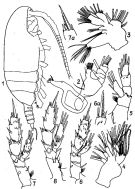 issued from : N.V. Vyshkvartzeva in Explorations of the Fauna of the Seas, 1993, 45 (53). [p.14, Fig.1]. Female (from NE Atlantic): 1, habitus (lateral right side); 2, Md; 3, Mx1; 4, Mx2; 5, P1; 6-6a, P2; 7-7a, P3; 8, P4. Nota: Exopod of Mx1 with 4 setae, endopod with 6 setae
|
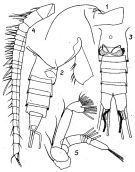 issued from : N.V. Vyshkvartzeva in Explorations of the Fauna of the Seas, 1993, 45 (53). [p.15, Fig.2]. Female: 1, forehead; 2, urosome (lateral right side); 3, idem (ventral); 4, A1; 5, A2. Nota: Genital segment as long as wide. 2nd and 3rd urosomal segments much wider than long. 2nd exopodal segment of P1 with an outer spine. Posterior surface of coxa of P4 with some large, lancet-form spines.
|
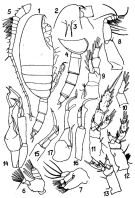 issued from : N.V. Vyshkvartzeva in Explorations of the Fauna of the Seas, 1993, 45 (53). [p.16, Fig.3]. Male: 1, habitus (lateral right side); 2, forehead (lateral); 3, rostrum; 4, last thoracic segment and urosome (lateralright side); 5, A1; 6, Md (mandibular palp); 7, Mx1; 8, Mxp; 9, P1; 10, basipod and endopod segments of P1; 11, P2; 12, P3; 13, P4; 14, P5; 15-16 left leg; 17, right leg.
|
 issued from : N.V. Vyshkvartzeva in Explorations of the Fauna of the Seas, 1993, 45 (53). [p.25, Fig.5]. As Female (from off Mauritania): 1, habitus (lateral right side); 2, idem (dorsal); 3, forehead (lateral); 4, last thoracic segment and urosome (lateral right side; 5, urosome (ventral); 6, genital segment; 7, A1; 8, A2; 9, Md10, Mx1; 11, Mx2; 12, P1; 13, P2; 14, P3; 15, P4.
Nota: Endopod of P1 with 2 inner setae and 2 distal setae. Exopod of mx1 with 5 setae, endopod with 7 setae. Lg: 0,96-1,20 mm
|
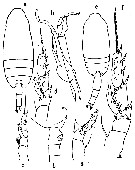 issued from : O. Tanaka in Publ. Seto Mar. Biol. Lab., 1961, IX (1). [p.184, Fig.124]. Female (from Japan: Sagami Bay): a, habitus (dorsal); b, last thoracic segment and urosomal segment 2 (lateral, right side); c, P1; d, P2. Nota : - Cephalothorax and abdomen in the proportional lengths 75 : 25. - Head and 1st thoracic segment fused, Th4 and Th5 incompletely separate. - Last thoracic segment with lateral margin bluntly angular in lateral view. - Rostral filaments long and slender. - Urosomal segments and caudal rami in proportional lengths 34 : 20 : 20 : 10 : 16 = 100. - Caudal rami 2 times as long as wide. - Endopod of A2 slightly longer than the exopod. - Terminal spine of exopod of P2 with 21 teeth. - Terminal spine of exopod of P4 with 19 teeth. - Posterior surface of exopod and endopod of P2 to P4 furnished with rows of minute spines. - P5 entirely absent. Male: e, habitus (dorsal); f, P2; g, P3 (part.); h, P5. Nota : - Cephalothorax and urosome in the proprtional lengths 64 : 36. - Urosomal segments and caudal rami in proportional lengths 8 : 37 : 22 : 22 : 5 : 8 = 100. - A1 20-segmented on the left (segments 8 to 12 fused, 24-25 fused); 19-segmented on the right side, extend to the end of the thorax. - Terminal spine of exopod of P2 with about 34 teeth. - P5 reaches back to the middle of the 3rd urosomal segment ; Rright leg with a long endopod, the distal end of the 1st segment of the exopod not produced ; left leg with a short exopod, endopod 2-segmented.
|
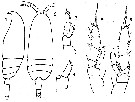 issued from : G.P. Farran in Biscayan Plankton collected during a Cruise of H.M.S. 'Research', 1900.- Part XIV. The Copepoda. (Linn. Journ. Zoology, XXXVI, 1926). [p.304, Pl.7, Figs.1-6]. As Scolecithrix curta. Female: 1-2, habitus (lateral and dorsal, respectively); 3, P1; 4, basipod 2 and endopod of P1 (another specimen); 5, P2; 6, P3.
|
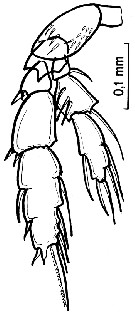 issued from : T.K.S. Björnberg in Bol. Inst. Oceanogr., Sao Paulo, 1963, XIII, 1. [p.42, Fig.22]. Female (25°15'-33°02'S, 46°18'-48°28'W): P4.
|
 issued from : O. Tanaka in Publ. Seto Mar. Biol. Lab., 1961, IX (1). [p.185] Male: Proportional lengths of the segments of A1.
| | | | | Compl. Ref.: | | | Sewell, 1948 (p.349, 502, 546, 550); Björnberg, 1963 (p.41, Rem.); Grice & Hulsemann, 1965 (p.224); 1967 (p.16); Furuhashi, 1966 a (p.295, vertical distribution in Kuroshio/Oyashio regions, Table 7, 9, 10); Fleminger, 1967 a (tabl.1); Park, 1970 (p.476); Roe, 1972 (p.277, tabl.1, tabl.2); Björnberg, 1973 (p.331, 389); Vives & al., 1975 (p.43, tab.II, III); Carter, 1977 (1978) (p.35); Dessier, 1979 (p.205); Vives, 1982 (p.292); Kovalev & Shmeleva, 1982 (p.84); Dessier, 1983 (p.89, Tableau 1, Rem., %); Scotto di Carlo & Ianora, 1983 (p.150); Scotto di Carlo & al., 1984 (1042); Brenning, 1984 (p.4, Rem.); 1985 a (p.28, Table 2); Brinton & al., 1986 (p.228, Table 1); Lozano Soldevilla & al., 1988 (p.58); Scotto di Carlo & al., 1991 (p.270); Gopalakrishnan & Balachandran, 1992 (p.167, figs.1, 4, Table 1, 2); Hure & Krsinic, 1998 (p.101); Gopalakrishnan & Saraledevi, 1998 (p.132, fig.5, chart); Suarez-Morales & Gasca, 1998 a (p.111); Razouls & al., 2000 (p.343, Appendix); Holmes, 2001 (p.58); Vukanic, 2003 (139, tab.1); Kuriyama & Nishida, 2006 (p.299: Tab.II; p.309: Tab.III, fig.7, 10, vertical distribution); Raybaud & al., 2008 (p.1765, Table A1); Brugnano & al., 2010 (p.312, Table 3); Cornils & al., 2010 (p.2076, Table 3); Schnack-Schiel & al., 2010 (p.2064, Table 2: E Atlantic subtropical/tropical); Mazzocchi & Di Capua, 2010 (p.427); Tutasi & al., 2011 (p.791, Table 2, abundance); Hidalgo & al., 2012 (p.134, Table 2) ; in CalCOFI regional list (MDO, Nov. 2013; M. Ohman, comm. pers.); Lidvanov & al., 2013 (p.290, Table 2, % composition); Zaafa & al., 2014 (p.67, Table I, occurrence); Bonecker & al., 2014 (p.445, Table II: frequency, horizontal & vertical distributions); Benedetti & al., 2016 (p.159, Table I, fig.1, functional characters); El Arraj & al., 2017 (p.272, table 2); Benedetti & al., 2018 (p.1, Fig.2: ecological functional group); Belmonte, 2018 (p.273, Table I: Italian zones). | | | | NZ: | 17 | | |
|
Distribution map of Scaphocalanus curtus by geographical zones
|
| | | | | | | | | | | | 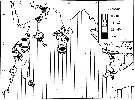 issued from : Gopalakrishnan & Saraledevi in Pelagic Biogeography ICoPB II. Proceedings of the 2nd International Conference. Final report of SCOR/IOC working group 93. Noordwijkerhout, The Netherlands 9-14 July 1995. Workshop Report No.142. UNESCO, 1998. [p.131, Fig.5]. issued from : Gopalakrishnan & Saraledevi in Pelagic Biogeography ICoPB II. Proceedings of the 2nd International Conference. Final report of SCOR/IOC working group 93. Noordwijkerhout, The Netherlands 9-14 July 1995. Workshop Report No.142. UNESCO, 1998. [p.131, Fig.5].
Distribution and abundance in number of specimens/standard haul of Scaphocalanus curtus in the Indian Ocean. |
| | | | Loc: | | | sub-Antarct. (SE Pacif.), South Africa (E) (off Durban, Natal), Namibia, Congo, G. of Guinea, off Morocco-Mauritania, Canary Is., off Madeira, Brazil, off Rio de Janeiro, off Amazon, Caribbean Sea, Caribbean Colombia, G. of Mexico, Florida, off Portugal, off W Cabo Finisterre, Bay of Biscay, off W Ireland, Ibero-moroccan Bay, off W Tangier, Medit. (M"Diq, Alboran Sea, NW Basin, Ligurian Sea, Tyrrhenian Sea, Naples, Strait of Messina, Adriatic Sea, Ionian Sea, Lebanon Basin), Indonesia (SW Celebes), SW Indian, Japan (Sagami Bay), SW Australia, New Zealand, California, Gulf of California, Galapagos-Ecuador, Chile, off Santiago, Straits of Magellan (Pacific area) | | | | N: | 62 | | | | Lg.: | | | (16) F: 1,060-1,034; M: 1,25; (35) F: 1,18-0,96; (36) F: 1,23-1,12; (38) F: 1,3-1,06; (108) F: 1,76-1,45; M: 1,9; (199) F: 1,6-0,99; M: 1,22; (237) F: 1,0; M: 0,95; (532) F: 1,05-0,93; (533) F: 1,16-0,99; (992) F: 0,93-1,3; M: 1,22-1,35; (1000) F: 1,6 ± 0,1; (1111) M: 1,34; {F: 0,93-1,76; M: 0,95-1,90} | | | | Rem.: | epi- meso-bathypelagic; epipelagic (in Farran, 1929).
Sampling depth (sub-Antarct.) : 100-500 m. 298-526 m at Station N-1 (SW Bösö, middle Japan) and Station H-12 (40°N, 152°E) from Furuhashi (1966 a).
Distributional range (m) from Roe (1972) Day: 350-500; from Grice & Hulsemann (1965): 200-1000 (in Kuriyama & Nishida, 2006).
For Björnberg (1963, p.42) this species is an indicator of deep water, registered for the first time in Brazilian waters, sampled with a closing-net between 108 and 54 m over the slope.
A doubt subsists on the attributions of the males of S. longifurca and S. curtus in Tanaka (1961 a), just as the synonymy with S. subcurtus.
Vyshkvertzeva (1993, p.12, 26) considers S. subcurtus Park, 1970 as a distinct species from S. curtus (Farran,1926).
All authors are not in accordance concerning the synonymy between S. curtus and S. similis maintened in WoRMS (2013) without justification.
After Benedetti & al. (2018, p.1, Fig.2) this species belonging to the functional group 5 corresponding to small sac-spawning detritivorous. | | | Last update : 25/10/2022 | |
|
|
 Any use of this site for a publication will be mentioned with the following reference : Any use of this site for a publication will be mentioned with the following reference :
Razouls C., Desreumaux N., Kouwenberg J. and de Bovée F., 2005-2025. - Biodiversity of Marine Planktonic Copepods (morphology, geographical distribution and biological data). Sorbonne University, CNRS. Available at http://copepodes.obs-banyuls.fr/en [Accessed January 01, 2026] © copyright 2005-2025 Sorbonne University, CNRS
|
|
 |
 |

















